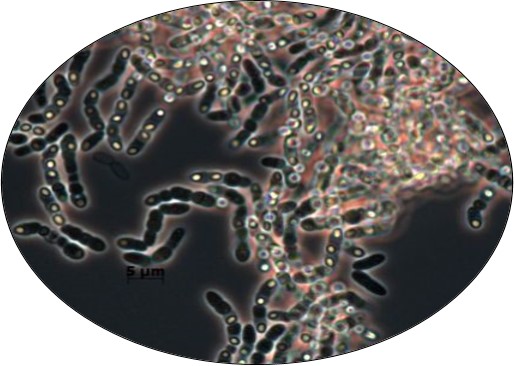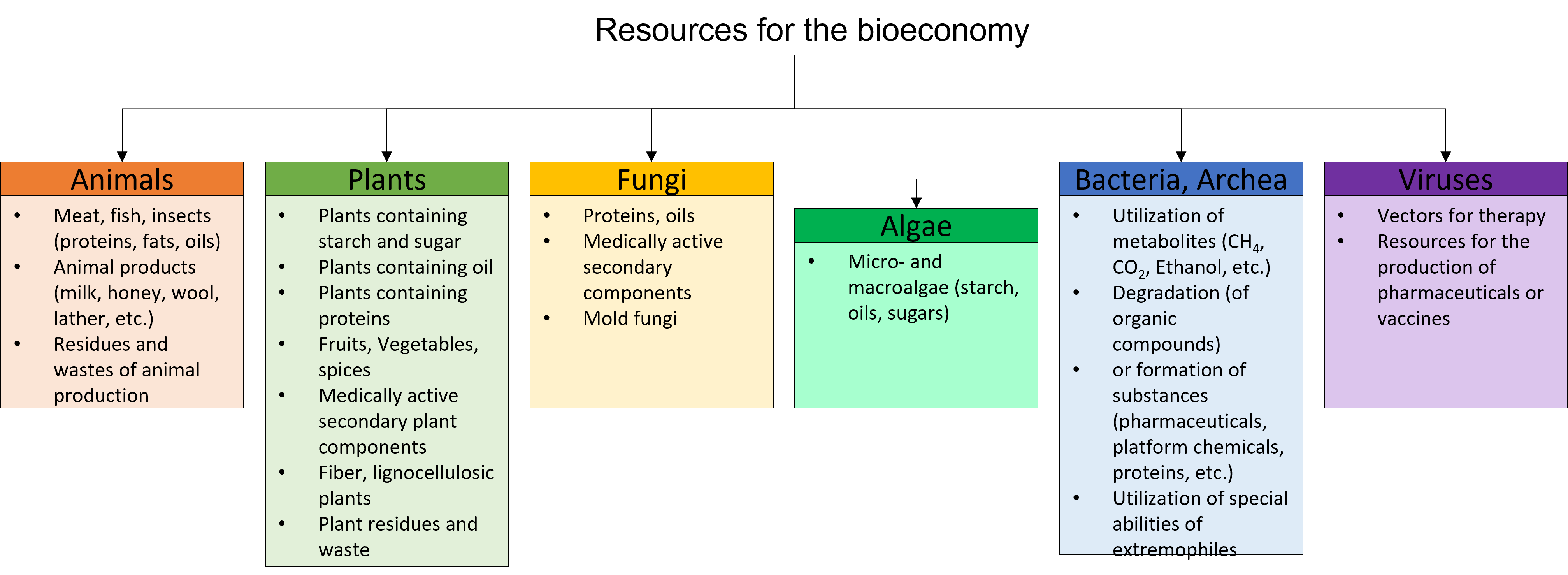2. Resources for the bioeconomy
| Website: | Hamburg Open Online University |
| Kurs: | Process engineering for the bioeconomy |
| Buch: | 2. Resources for the bioeconomy |
| Gedruckt von: | Gast |
| Datum: | Mittwoch, 10. Dezember 2025, 22:56 |
Beschreibung
This book provides an overview of the diverse raw material base of the bioeconomy.
2. Resources for the bioeconomy
The basics
As the name suggests, the bioeconomy is based on organic raw materials derived from animals, plants, fungi, algae or microorganisms. This so-called biomass, as well as its remnants and waste, can be used to generate energy or new products. This chapter provides an overview of the diverse raw material base of the bioeconomy.
- Land
- Water
- Nutrients
Furthermore, bio-based products cannot be produced on a large scale without the use of human labor, technology and infrastructure. Humans have increased the yield of plants through breeding and further increased it through mechanical cultivation. Without these resources, the large number of people on earth could not be fed and supplied with products.
2.1 Plant origin
Agricultural Plantation
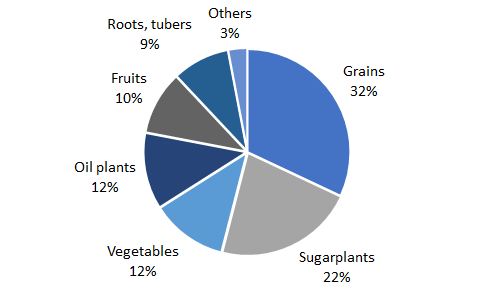
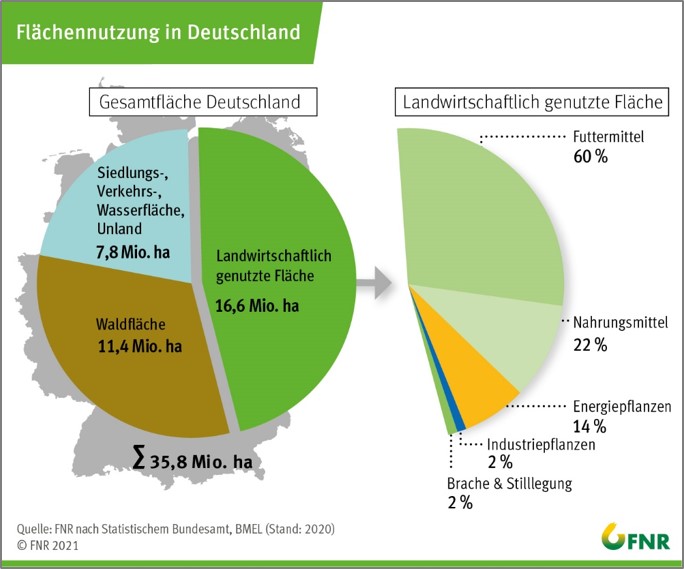
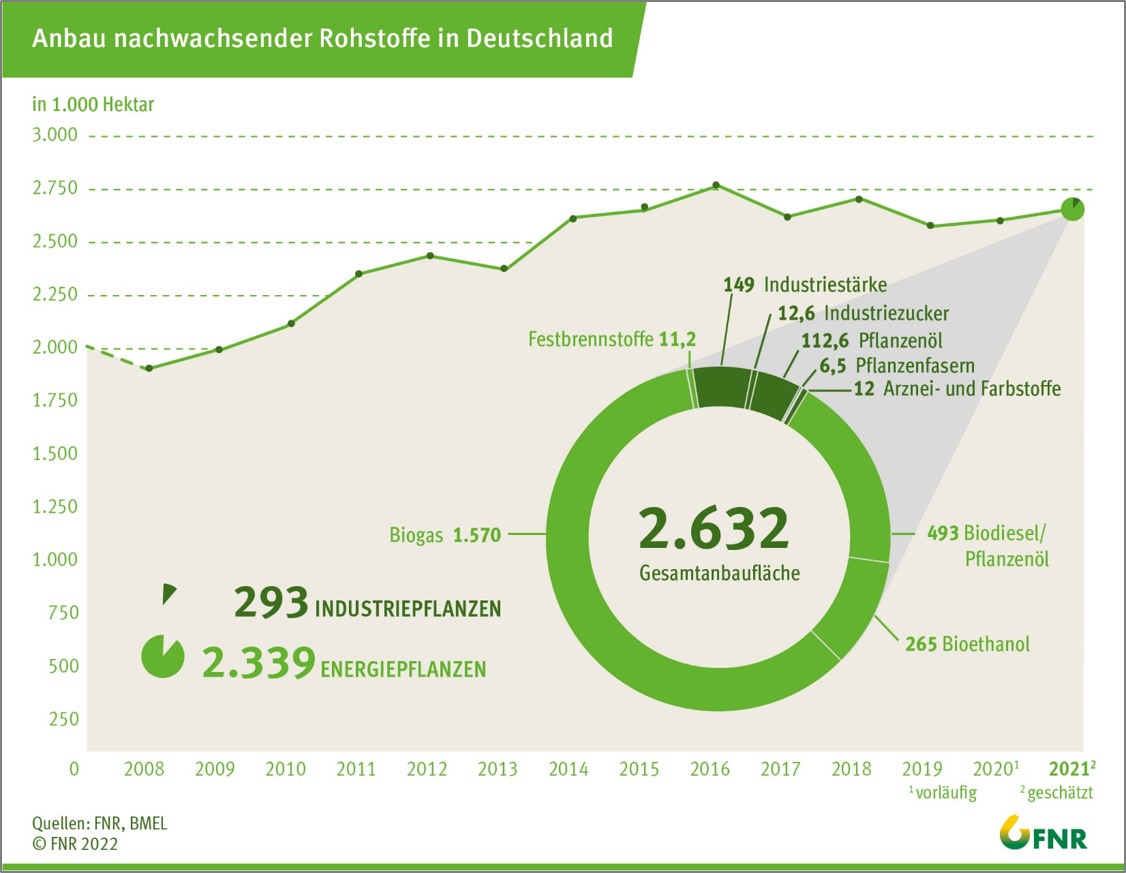
https://www.fnr.de/ftp/pdf/berichte/22004416.pdf
Important plant groups
A distinction can be made on the basis of the mainly used organic ingredients of the plants:- Sugar and starch-containing plants
- Protein-containing plants
- Oil-containing plants
- Lignocellulosic plants
- Medical plants, cosmetically used plants
This article provides an overview of which agricultural waste and by-products can be used for biorefinery processes: https://www.frontiersin.org/articles/10.3389/fenrg.2020.00152/full
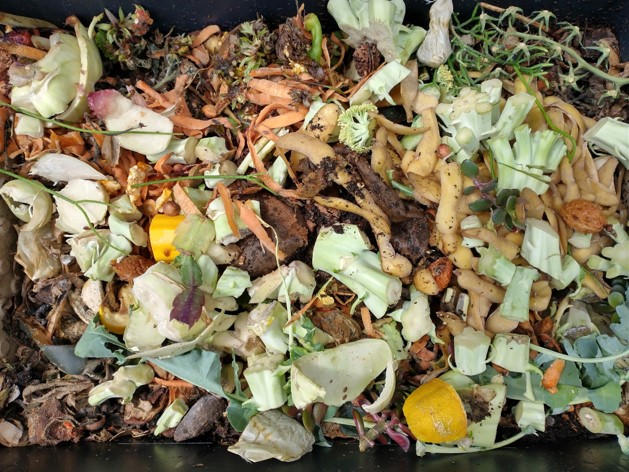
Sugar
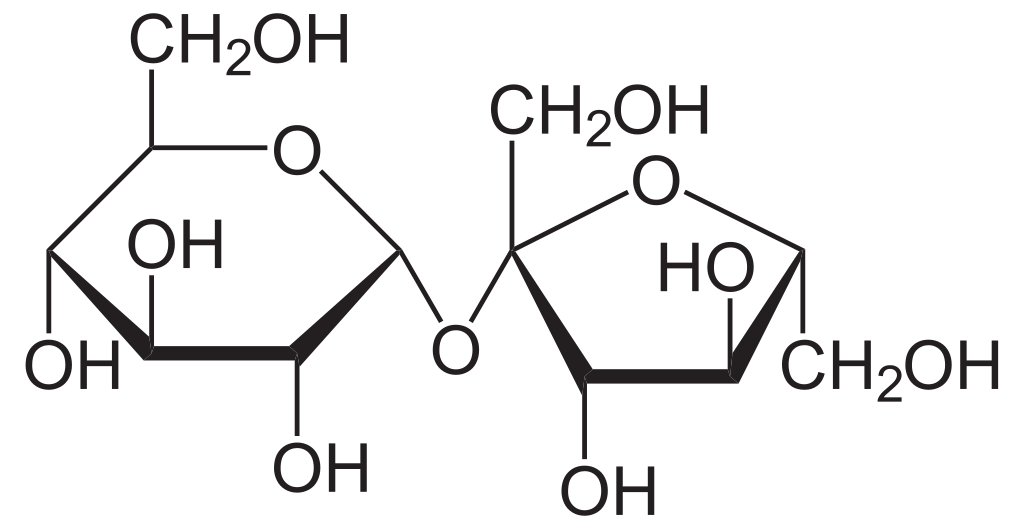
Important sugar-containing crops
1.9 billion tons of sugar cane and 270 million tons of sugar beet were produced worldwide in 2021 (FAO 2022). Important sugar cane growing countries are Brazil (38%) and India (22%), which together produce 60% of the total harvest (FAO 2022). In Brazil, around 45% of the sugar cane produced is used for the production of bioethanol (https://encyclopedia.pub/entry/17495).
World Bioethanolproduction 2021: 104,5 Mrd.l (https://www.isosugar.org/sugarsector/ethanol). Of which a total of approx. 25 % from sugar cane (Hoang 2021, https://encyclopedia.pub/entry/17495)
Sugar beet is mainly grown in Russia, France, the USA, Germany and Turkey. They are mainly processed into sugar. Around 31.9 million tons of sugar beet were produced in Germany in 2021 (BLE 2022). However, some of the sugar beet grown is also used to produce ethanol or biogas. In Germany, around 1.3 million tons of sugar beet were used for ethanol production in 2021 and around the same amount for biogas production (FNR 2022).
The variety of products made from sugar beet is shown on this website.
Statistical data on the cultivation and use of sugar beet in Germany are summarized in this report by the Bundesanstalt für Ernährung und Landwirtschaft.

Starch
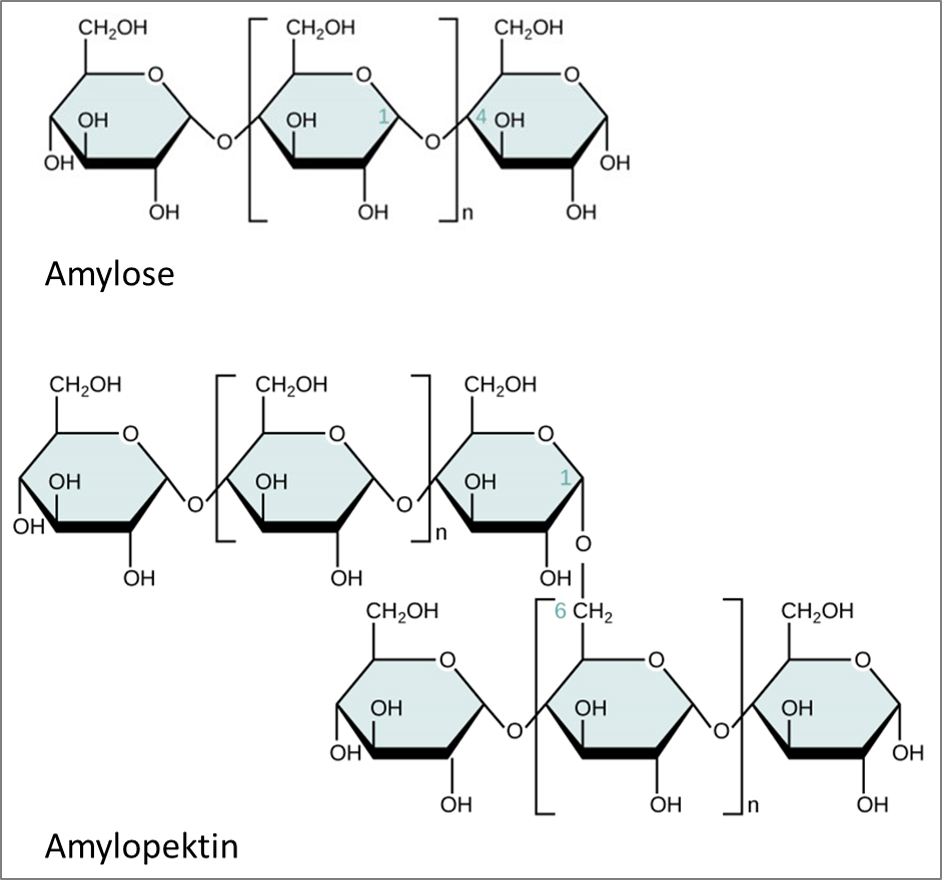
Important starch-containing crops
Maize or corn
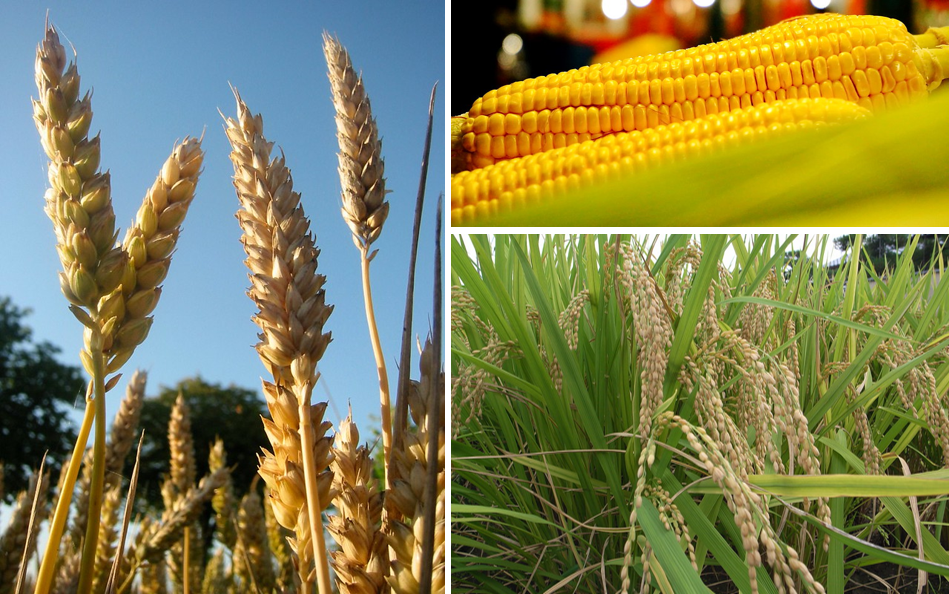
60% of the rice produced worldwide (2021: 787 million tons) is grown in China (27%), India (25%) and Bangladesh (7%). Rice is mainly used for food production.
Wheat
Wheat cultivation is not so strongly concentrated in individual producing countries. Only 40 % of the 787 million tons of wheat produced worldwide is produced in three countries: China (18 %), India (14 %) and Russia (10 %). The remaining 60% is produced in various other parts of the world. The quantities produced in China and India are also consumed there, while Russia, the USA, Canada, the EU and Ukraine export large parts of their production (Wolf et al. 2018)
Around 80% of wheat is used for food production, the rest for industrial applications or as animal feed.
In Germany, around 21.5 million tons of wheat were grown on 2.9 million hectares in 2021. Around 3% of this quantity was used for bioethanol production (FAOSTAT 2022 and FNR 2022).
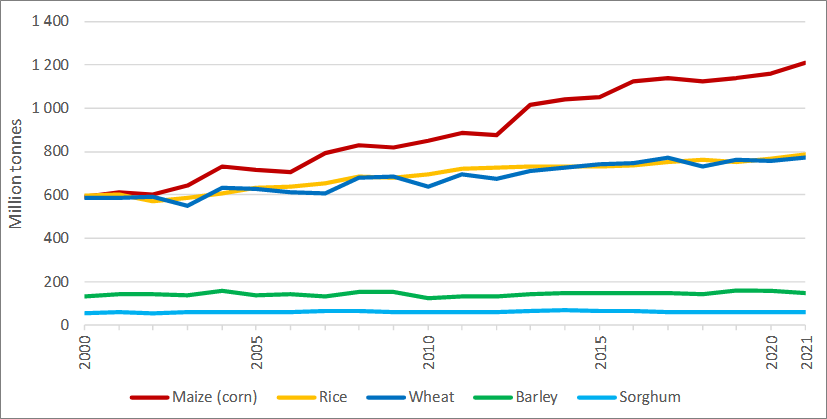
Protein-containing plants
Proteins are amino acid molecules linked together via peptide bonds. Plants need nitrogen to build these.
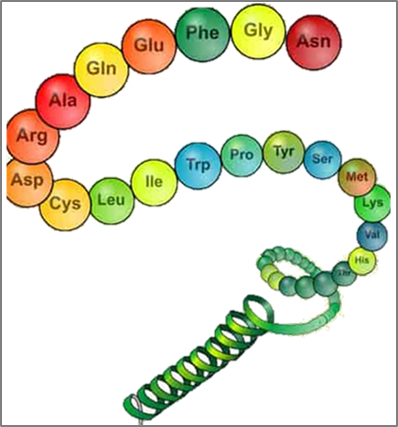
Protein plants are mainly cultivated for their fruits or seeds with a high protein content and are used as food or animal feed. The most important crops are from the legume family, i.e. the papilionaceous plants. These include peas, beans, lentils and soybeans, which are usually referred to as pulses by the name of their superordinate family.
In 2021, pulses were grown on more than 95 million hectares. Beans (38%), chickpeas (16%) and black-eyed peas (16%), which are mainly grown in warmer regions in Africa, Latin America and Southeast Asia, accounted for the largest share. Almost 89 million tons of pulses were harvested from these areas worldwide in 2021. Beans (31%), chickpeas (18%), peas (14%) and black-eyed peas (10%) accounted for the largest shares of this harvest volume.
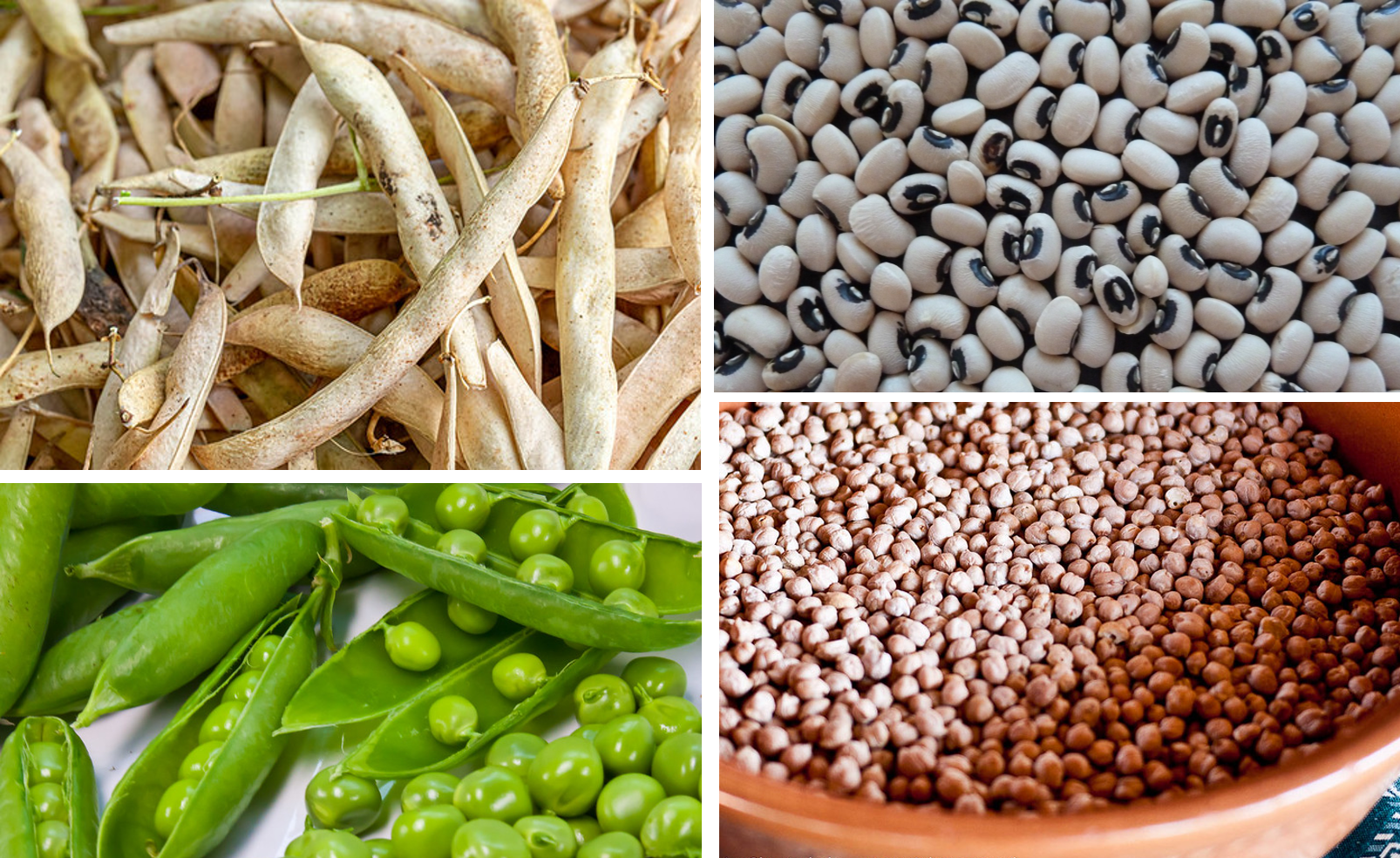
Oil-containing plants
Chemistry of oils and fats
Chemically speaking, oils and fats are esters of glycerol and three fatty acid units (triglyceride). They consist of 8 and 24 carbon atoms, hydrogen and oxygen.
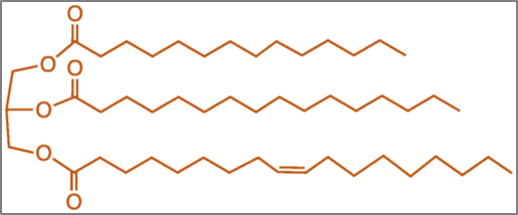
Oils and fats have the same general chemical structure, but oils are liquid under standard conditions (25 °C) and fats are solid. Oils are often of vegetable origin and fats of animal origin.
Oils and fats are mixtures of substances and do not have an exact melting point, but a melting range. They are insoluble in water.
They are referred to as saturated fatty acids if the carbon atoms are connected via single bonds.
Palmic acid by Anne Rödl (CC 0)
Oleic acid by Anne Rödl (CC 0)
Oils and fats serve as energy sources or energy stores in plants, but also as solvents for fat-soluble vitamins. Plants often store oil in seeds and sometimes in the fruit flesh. It can be extracted from there.
Cultivation
The global area under oilseed crops in 2021 was around 338 million hectares, with a harvest volume of 1.2 billion tons.
Soybeans are not only a source of protein, but also a very important source of oil. Soy was grown on almost 130 million hectares worldwide in 2021 (FAOSTAT 2022), producing 373 million tons of soy.
The largest soybean-growing countries are Brazil, the USA and Argentina. Together, they produce over 80% of the world's soy.

Cultivation of oil-containing plants by Anne Rödl (CC BY)
As the oil plants differ greatly in their yields per hectare, a slightly different distribution emerges when looking at the quantities produced. Oil palms have a much higher specific yield than other oil plants and therefore account for the majority of the global harvest. Oil palms were cultivated on almost 29 million hectares worldwide, producing 416 million tons of oil fruits. The most important producing countries, together accounting for 87% of the global production volume, are Indonesia, Malaysia and Thailand (FAO 2022). Cotton seeds are mainly grown in China, India and the USA.
An even more detailed portrait of the most important oil plants and oil production can be found in chapter 1.2 of the Future Fuels learning offer on the HOOU platform.
Lignocellulosic plants
Structure and composition
Starch is chemically converted by plants into other required reserve substances (fats and proteins) or secondary plant substances (tannins, alkaloids or essential oils) as required. These secondary plant substances are also very interesting for the bioeconomy and are therefore described in more detail in the chapter on plant-based medicines. Lignin is another such secondary plant substance. Perennial plants store it in their cell walls for stabilization. Because of this structural tissue of lignin and cellulose, they are referred to as lignocellulosic plants. The respective proportion of cellulose, hemicellulose and lignin depends on the species and the site conditions. The following table provides an overview of the composition and properties of important lignocellulosic plants.
|
Plant |
Cellulose |
Hemicellulose |
Lignin |
Ash |
Water content |
Heating value |
|
|
(% DM) |
(% DM) |
(% DM) |
(%) |
(% FM) |
(MJ/kg) |
|
Miscanthus |
44-57 |
16-30 |
8-22 |
1-9 |
3-49 |
15-21 |
|
Reed canary grass |
26-39 |
17-28 |
4-5 |
2-13 |
7-65 |
16-20 |
|
Elephant grass |
34-42 |
20-23 |
8-24 |
6-10 |
74 |
18 |
|
Common reed |
34-38 |
21-28 |
19-23 |
3-8 |
16 |
14-15 |
|
Giant reed |
31-39 |
21-35 |
18-23 |
3-6 |
36-42 |
14-15 |
|
Switchgrass |
30-45 |
21-35 |
5-23 |
2-10 |
8-15 |
17-19 |
|
Sugarcane |
34-42 |
29-43 |
19-21 |
2-12 |
6-50 |
17-18 |
|
Wheat straw |
29-52 |
11-39 |
8-30 |
1-19 |
10-17 |
15-21 |
|
Maize straw |
28-51 |
19-30 |
11-17 |
4-10 |
5-6 |
17-19 |
|
Softwood |
35-83 |
8-42 |
12-43 |
1-6 |
0-63 |
16-24 |
|
Hardwood |
28-50 |
18-39 |
13-28 |
0.2-5 |
2-48 |
15-21 |
|
Energy forestry (poplar, willow) |
35-80 |
13-42 |
15-32 |
0.2-5 |
2-50 |
17-20 |
DM: Dry mass; FM: Fresh mass
Forest wood
Forestry is an important supplier of economically significant quantities of lignocellulose raw materials. The world's forests produce wood as building and construction materials, for pulp and paper production and for energy generation. Wood is one of the most important bio-based resources used by humans and has been used for a wide variety of applications for thousands of years.
Humans manage a large proportion of the world's forests. Primeval forests as defined by the FAO still exist on 1.11 billion hectares, which is approx. 27 % of the total forest area (4.06 billion hectares), covering approx. 31 % of the global land area. The largest shares of forest areas are located in tropical (45 %) and boreal (27 %) zones of the earth (FAO 2020). The following figure shows the proportion of forest area in relation to the total area of the individual countries of the world.
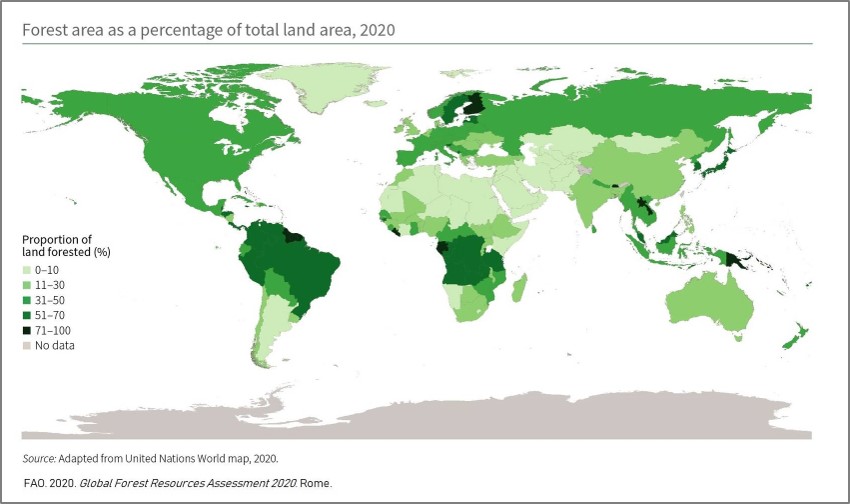
- Sowing, planting or promoting natural regeneration
- Pruning, thinning or branching to reduce stand density and improve the quality of the remaining trees
- Harvesting measures
The harvested logs can be divided into roundwood, industrial wood and pulpwood, which are primarily processed in the forestry industry. Not all parts of the tree are sold to the wood and paper processing industry. In most cases, weak tree parts, branches and the crown remain in the forest (residual forest wood) and serve as fertilizer for the forest soil after rotting. Increasingly, however, these assortments are also of interest to the energy industry. They are often used as firewood or are also of interest for biorefineries. However, care should be taken to ensure that sufficient residual wood remains in the forest for the supply of nutrients and for other ecological reasons (e.g. biodiversity).
The wood processing industry is strongly oriented towards softwood, as it grows predominantly straight and fast and has good properties for building and construction applications due to its lower density and simultaneous tensile and bending strength. Hardwood is often used in furniture construction and interior fittings. But even there, chipboard and fiberboard made from inferior softwood grades are increasingly being used for cost reasons and to reduce weight.
Around 1.4 billion m³ of softwood logs and 2.5 billion m³ of hardwood were harvested worldwide in 2020 (FAOSTAT 2023).
Around 117 million m3 of wood grows in German forests every year (bwi.info). To get a better idea of how much this is, a wooden cube is often used to visualize the growth of wood per second. For Germany, this cube would have an edge length of 1.55 meters.

In some regions, trees are mainly grown in plantations. In South America, plantations account for 99 % of planted forests (FAO definition of “Planted Forests”), whereas in Europe they account for just 6 % (FAO 2020). A plantation is usually established with only one tree species, at the same age and in a regular arrangement and is usually used for the rapid production of wood for fiber (for pulp production) or energy production (FAO definition).
Lignocellulosic biomass can also be supplied from agricultural or landcare waste streams, as well as from industry or demolition materials.
Lignocellulosic biomass is often considered a promising feedstock for biofuel production as it is an abundant source of organic material that is not in direct competition with food and feed. The lignocellulosic molecules can be cracked in an oxygen-free atmosphere by pyrolysis, they can be gasified and then liquefied using a Fischer-Tropsch synthesis, or they can be converted to sugar and then to alcohol.
Animal origin
By metabolizing their food, animals build up proteins and fats in their tissues, which in turn can serve as food for humans and animals. Animals also produce various products that are used by humans, such as honey, milk, eggs or wool. However, excretions or leftovers (skins or bones) are also used in a variety of ways. Raw materials of animal origin are mostly used in the food and animal feed industry. However, residues are also used as fertilizer or in biogas production. A relatively new branch is the production and use of insects as a source of protein for humans and animals. In 2021, for example, the EU approved mealworms as a “novel food”.
Current list of “novel foods” authorized in the EU
Seeing the bigger picture
What are alternative proteins?
Alternative proteins are proteins produced by algae or fungi, come from insects or are cultivated from cells in the laboratory. They are used to produce meat substitutes, animal feed or as a milk alternative.
This branch of the bioeconomy is attracting more and more attention for various reasons. One reason is concern about the future food supply for a growing world population, another is ethical and environmental concerns about conventional meat and dairy products and the trend towards vegetarianism or veganism.
A start-up founded by graduates of Hamburg University of Technology uses bacteria to produce high-quality proteins for food and animal feed.
